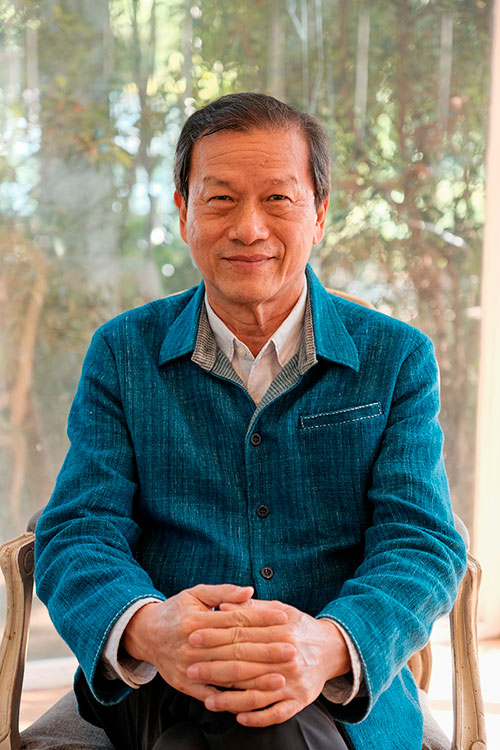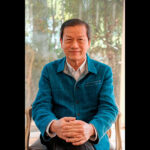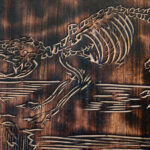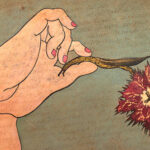Roma – 4 Marzo 2025 by Vittoria Biasi
Translation by C.E. Glatz

La Bangkok Art Biennale, Nurture Gaia (24 Ottobre 2024- 25 Febbraio 2025), è stata ideata dal direttore artistico Apinan Poshyananda, che traccia un percorso di analisi e di ricerca espressiva con artisti di diverse nazionalità.
Il titolo Nurture Gaia, richiamando le mitologiche divinità della terra di cui siamo figli, determina i valori teorici dell’esposizione. Il direttore, che ha una concezione umanistica e filosofico/religiosa sul rapporto Uomo-Natura, nel rispetto delle identità culturali, ha invitato a esporre nella Bangkok Art Biennale artisti storicamente riconosciuti o di territori emergenti impegnati nel senso profondo della loro storia, della loro visione collegata all’essenza di un linguaggio. La mostra presentata in 11 luoghi istituzionali, tra cui alcuni di rilevante valore per il pensiero religioso orientale, suscita grande sentimento. Questo attraversa le sfide dell’arte e il piacere della relazione con l’altro.
V. B. – Lei direttore Professore Apinan Poshyananda è l’ideatore e il padre della Biennale di Bangkok. La sua vasta esperienza maturata in un importante percorso professionale lo ha condotto a questo grande progetto: Bangkok Art Biennale. La sua esperienza include numerose partecipazioni alla Biennale di Venezia in qualità di curatore del Padiglione Thai e le riflessioni sul valore di un’istituzione artistica come la Biennale che valica i confini nazionali.
L’ospitalità culturale della Tailandia ha una storia ricca e documentata. Nella Biennale di Venezia (2003), il titolo della mostra del Padiglione Tailandese, Reverie and Phantasm in the Epoch of Global Trauma, è il riferimento al nuovo percorso storico-culturale avviato dalla visita del re del Siam, Sua Altezza Chulalongkorn alla prima Esposizione Internazionale d’arte nel 1895.
Per la Biennale di Venezia del 2007, Pensa coi sensi-Senti con la Mente, lei approfondisce il concetto della globalizzazione e della trasmigrazione di un pensiero dall’Oriente all’Occidente nel testo per la mostra di Amrit Chusuwan e di Nipan Oranniwesna evidenziando l’identità sensoriale e culturale del comportamento orientale.
Vorrei porre due domande inseparabili che riguardano la situazione della cultura in Thailandia e il titolo della Bangkok Art Biennale Nurture Gaia. Nel momento storico di grande trasformazione, quale è stato il suo pensiero nel formulare il titolo, che, apparentemente semplice, è un contenitore di cultura e problematiche sociali?
A. P. – Dal 2003, quando ho curato il padiglione thailandese intitolato Reverie and Phantasm in the Epoch of Global Trauma alla 50a Biennale di Venezia, abbiamo affrontato traumi profondi, catastrofi e distruzione dell’ambiente. Tali circostanze sfortunate sono state il risultato dell’avidità umana, dell’egoismo e della sete di potere. Nurture Gaia, che è il tema della Biennale d’arte di Bangkok 2024, è semplice ma con molti riferimenti e valori, collegati tra loro, che riflettono la crisi dovuta alla mancanza di rispetto verso Madre Natura, causando danni al comportamento umano. In politica, le guerre in corso sono più minacciose poiché i leader mondiali sembrano non avere idea di come fare la pace tra opposizioni spaventose. Nurture Gaia richiama l’attenzione sul delicato rapporto tra umanità e natura. Riferendosi a Gaia, la dea greca, figlia del Caos, in relazione alla Terra e alla Maternità. Nella versione thailandese, Raksa Gaya significa guarigione del corpo fisico e della mente. Con l’enfasi sulla cura, la sostenibilità e la resilienza, incoraggia la riflessione sui pressanti problemi sociali e ambientali del nostro tempo.
V. B. – Come hanno risposto gli artisti al suo invito a riflettere sul rapporto dell’arte con la natura e sulle difficili questioni sociali e culturali?
A. P. – La risposta degli artisti al tema è stata estremamente entusiasta. Che si tratti di selezione di opere esistenti o di nuove committenze, gli artisti sono stati molto collaborativi. Il team curatoriale ha selezionato 77 artisti provenienti da 39 paesi insieme a un Open Call, quindi abbiamo una vasta partecipazione da Europa, Asia e Oceania. Ad esempio, noi abbiamo commissionato installazioni a Choi Jeong Hwa, Amanda Coogan, Gimhongsok, Elmgreen & Dragset, Tony Cragg, Haritorn, Dusadee Huntrakul, Nakrob Moonmanas, Mella Jaarsma, Agus Ongge, Cole Lu, Zul Mahmod, Bagus Pandega & Kei Imazu, Bounpaul Phothysan e Moe Satt. Gli artisti italiani sono Chiara Camoni, Daniela Comani, Lello Esposito.
V. B. – Per l’ultima Biennale di Venezia Foreigners Everywhere lei realizza il progetto in cui formalizza alcune problematiche migratorie con l’opera The Spirits of Maritime Crossing, in cui Marina Abramović viaggia da Venezia a Bangkok, dove incontra il Re Scimmia interpretato da Pichet Klunchun.
Il video, di cui lei è il regista, affronta racconti storici dolorosi. Gli artisti Chitti Kasemkitvatana e Nakrob Moonmanas, Jompet Kusuwidananto, Alwin Reamillo, Natee Utarit, Bounpaul Phothyzan, Khvay Sammang, Yee-I- Lann con le comunità marina, Truong Cong Tuang, Jakkai Siributr in collaborazione con i richiedenti asilo, e Moe Satt, Priyageetha Dia, Kawita Vatanajyankur con le loro opere denunciano le violenze sociali e culturali, che colpiscono anche la madre terra e la religiosità che lei porta e offre.
Quale messaggio, quale progetto dell’arte è all’origine di questa innovazione nella biennale?
A. P. – Alla 60a Biennale di Venezia con il tema Foreigners Everywhere, il nostro padiglione The Spirits of Maritime Crossing è stato selezionato come parte dell’evento collaterale ufficiale. Collocato a Palazzo Mangilli Valmarana sul Canal Grande, il padiglione ha esposto opere legate all’esodo, alla diaspora e alle diverse condizioni di estraneità, che sono stati affrontati da artisti provenienti da Laos, Cambogia, Vietnam, Indonesia, Malesia, Filippine, Singapore e Thailandia. Inoltre, un film su uno spirito errante interpretato da Marina Abramovic viaggia da Venezia a Bangkok in cerca di pace e tranquillità. L’intenzione è di sollevare questioni riguardanti la definizione di stranieri e di alcuni stranieri che sono più uguali di altri. Invece di rappresentare un padiglione nazionale, offriamo opportunità per artisti provenienti da Laos, Cambogia e Vietnam. Sfocando le nazionalità offriamo collaborazione tra artisti che sperimentano l’estraneità a causa della supremazia coloniale, degli stereotipi e della stigmatizzazione. Questo è il concetto di spiriti che si muovono attraverso mari e oceani, a partire da Marina Abramovic che sorge dal cimitero di San Michele e si avventura in luoghi estranei a Bangkok in cerca di rifugio. Gli artisti del Sud-est asiatico esprimono attraverso la loro esperienza lavorativa traumi, razzismo, stereotipi e repressione. Molti di loro si concentrano non tanto sulle identità nazionali quanto sugli spazi intermedi della terra di nessuno.
V. B. – La Biennale d’arte di Bangkok, intitolata Nurture Gaia, espone opere di 76 artisti provenienti da 39 paesi. Si svolge nei luoghi più suggestivi della città di Bangkok con un allestimento molto rispettoso. Qual è la corrispondenza tra le opere d’arte e questi luoghi così ricchi di storia? Lo spettatore può gestire questa proposta culturale? Qual è stato il suo itinerario espositivo?
A. P. – Come la Biennale di Venezia, vogliamo che gli spettatori interagiscano con il patrimonio culturale mentre visitano le nostre sedi. Per questa edizione siamo in grado di collocare opere di Chiara Camoni, Ravinder Reddy, Joseph Beuys, Komkrit Theptian, Nakrob Moonmanas e Haritorn Akarapat al National Museum nell’ex palazzo reale. Alla National Gallery e al Museum Siam, che sono edifici in stile coloniale progettati da Mario Tamagno, espongono installazioni e media art su transgender, animismo, corpo e anti-fallocentrismo. Ci è stato concesso il permesso di esporre più di 100 manufatti di dee, linga, yoni e vasi provenienti dal deposito nazionale. Accostate all’arte contemporanea, queste immagini sacre aggiungono nuove dimensioni al significato di Gaia e Madre Terra.
V. B. – Nurture Gaia è una biennale importante perché ripristina la fiducia nell’arte. I problemi che affliggono la società, le culture e le persone nel Sud del mondo, vengono affrontati con un significativo pensiero filosofico-religioso. In questo senso, qual è la relazione tra la funzione dei templi e gli artisti che sono stati esposti negli spazi dei templi Wat Arun, Wat Bowon, Wat Pho e Wat Prayoon?
A. P. – Nurture Gaia non affronta solo le questioni del Sud del mondo, ma anche argomenti di mito, adorazione della dea e animismo. La narrazione fantascientifica di Lisa Reihana sugli antenati Māori e i viaggiatori per mare; i dipinti di Busui Ajaw sul folklore Akha e Amamata, venerata madre della fertilità e del culto degli antenati; Aideen Barry fa rivivere il folklore irlandese fuorilegge, la lingua madre e la musica con il canto gutturale Inuit, l’arpa irlandese e i ritmi elettronici.
La relazione tra la funzione dei templi e gli artisti consente di esporre opere site-specific in recinti sacri. A Wat Arun, le sculture in fibra di vetro di Haritorn Akarapat sono collocate sullo sfondo di iconici stupa. A Wat Pho, Eyes di Louise Bourgeois è installato in un giardino adiacente al Tempio del Reclining Buddha. Yanawit Kunchaethong ha prodotto stampe e dipinti con vernice organica ricavata da specie di piante. Le sue piccole opere sono appese in lode di Madre Natura di fronte a murales tradizionali raffiguranti spiriti del parto e cure mediche. Good like Gaia di Lello Esposito, un corno gigante color corallo, si erge magnificamente accanto a uno stagno mitologico con centinaia di tartarughe a Wat Prayoon. A Wat Bowon Niwet, Cole Lu crea motivi bruciati fatti a mano su portali di legno che evocano il ciclo di nascita e morte.
The Bangkok Art Biennale, Nurture Gaia, was conceived by the artistic director, Apinan Poshyananda, who traces a path of analysis and expressive research by artists of different nationalities.
The title, Nurture Gaia, which recalls the mythological gods of the earth of which we are its children, establishes the theoretical meanings of the exhibition. The director has a humanistic and philosophical/religious conception of the relationship between human beings and nature, in respect of cultural identities. As such, the artists he has invited to exhibit at the Bangkok Art Biennale are historically recognized artists or are from emerging territories committed to a deep sense of their history and their vision connected to the essence of a style. The exhibition is spread out over 11 institutional venues, including some of significant value to Eastern religious thought. It also arouses great emotions as it traverses the challenges of art and the pleasure of relationships with others.
V. B. – Dr. Apinan Poshyananda, you are the creator and “father” of the Bangkok Biennale. Your wealth of experience over an important career path led you to this great project: Bangkok Art Biennale. Your experience includes being the curator of the Thai Pavilion numerous times at the Venice Biennale and offering reflections on the value of having an art institution like the Biennale transcend national borders.
Thailand’s cultural hospitality has a very rich and well-known history. On the Venice Biennale (2003), the title of exhibition for the 2003 Thai Pavillon, Reverie and Phantasm in the Epoch of Global Trauma, is always present as a reference to the new cultural-historical path initiated by King Chulalongkorn of Siam’s visit to the first International Art Exhibition in 1895.
For the 2007 Venice Biennale, Think with the Senses – Feel with the Mind, you explored the concept of globalization and “the process of adopting a foreign culture, concept or philosophy of life, whether its flow is east to west, or vice versa”, according to the text written for the exhibition by Apisak Sonjod. Artists Amrit Chusuwan and Nipan Oranniwesna highlighted the sensory and cultural identity of behavior in the East.
I would like to ask two questions that are connected concerning culture in Thailand and the title of the Bangkok Art Biennale Nurture Gaia. In this historical moment of great transformation, what was going through your mind when you came up with the title, which seems simple but contains many cultural and social issues?
A. P. – Since 2003, when I curated the Thai Pavilion entitled Reverie and Phantasm in the Epoch of Global Trauma at the 50th Venice Biennale, we have faced deep trauma, catastrophe and destruction of the environment. Such unfortunate circumstances have been the result of human greed, selfishness and power mongering. Nurture Gaia, which is the theme of Bangkok Art Biennale 2024, is simple but full of multilayered meanings reflecting crises due to the disrespect of Mother Nature and the detriments caused by human behavior. In politics, ongoing wars are the most threatening as world leaders seem to have no idea how to make peace among frightening oppositions.
Nurture Gaia draws attention to the delicate relationship between humanity and nature. It refers to Gaia, the Greek goddess, the daughter of Chaos, relating to Earth and Motherhood and, in the Thai version, to Raksa Gaya, which means healing the physical body and mind. With the emphasis on care, sustainability and resilience, it encourages reflection on the pressing social and environmental issues of our time.
V. B. – How did artists respond to your invitation to reflect on art’s relationship with nature and with hot-button social and cultural issues?
A. P. – The artists’ response to the theme was extremely enthusiastic. Whether selecting existing works or new commissions, the artists have been most cooperative. The curatorial team selected 77 artists from 39 countries together with an Open Call so we have a wide-ranging selection from Europe, Asia and Oceania.
For instance, we have commissioned installations by Choi Jeong Hwa, Amanda Coogan, Gimhongsok, Elmgreen & Dragset, Tony Cragg, Haritorn, Dusadee Huntrakul, Nakrob Moonmanas, Mella Jaarsma, Agus Ongge, Cole Lu, Zul Mahmod, Bagus Pandega & Kei Imazu, Bounpaul Phothysan and Moe Satt. Italian artists include Chiara Camoni, Daniela Comani and Lello Esposito.
V. B. – At the last Venice Biennale, Foreigners Everywhere, you produced a project in which you developed some issues dealing with migration with the work, The Spirits of Maritime Crossing, in which Marina Abramović travels from Venice to Bangkok, where she meets Monkey King played by Pichet Klunchun. The video, which you directed, deals with painful historical narratives.
With their work, the artists Chitti Kasemkitvatana, Nakrob Moonmanas, Jompet Kusuwidananto, Alwin Reamillo, Natee Utarit, Bounpaul Phothyzan, Khvay Sammang, Yee-I- Lann and the sea-based communities, Truong Cong Tuang, Jakkai Siributr in collaboration with asylum seekers, Moe Satt, Priyageetha Dia and Kawita Vatanajyankur denounce social and cultural violence, which also affects Mother Earth and the religiosity she brings and offers.
What effort – what art project – is behind this innovation at the biennale?
A. P. – At the 60th Venice Biennale with the theme Foreigners Everywhere, our pavilion, The Spirits of Maritime Crossing, was selected as part of the official collateral event. Located at Palazzo Mangilli Valmarana on the Grand Canal, the pavilion displayed works related to displacement, diaspora and layers of foreignness represented by artists from Laos, Cambodia, Vietnam, Indonesia, Malaysia, Philippines, Singapore and Thailand. Moreover, a film on a wandering spirit played by Marina Abramović travels from Venice to Bangkok in search of peace and tranquility. The intention is to raise issues regarding the definition of strangers and that some foreigners are more equal than others. Instead of representing a national pavilion, we offer opportunities for artists from Laos, Cambodia and Vietnam. By blurring nationalities we offer collaboration among artists who experience foreignness due to colonial supremacy, stereotypes and stigmatization. There is the meaning of spirits moving across seas and oceans starting with Marina Abramović rising from the graveyard at San Michele and venturing to estranged places in Bangkok in search of refuge. Artists from Southeast Asia express through their work the experience of trauma, racism, stereotyping and suppression. Many of them focus not so much on national identities but on the in-between spaces of no man’s land.
V. B. – The Bangkok Art Biennale, titled, Nurture Gaia, is exhibiting works by 76 artists from 39 countries. It is taking place in Bangkok in the city’s most evocative locations in a set-up that is very respectful.
What is the correspondence between the works of art and these places that are so rich in history? Can the spectator manage this cultural proposal? What was your exhibition itinerary?
A. P. – Like the Venice Biennale, we want viewers to interact with the cultural heritage as they visit our venues. For this edition, we are able to place works by Chiara Camoni, Ravinder Reddy, Joseph Beuys, Komkrit Theptian, Nakrob Moonmanas and Haritorn Akarapat at the National Museum in the former royal palace. The National Gallery and Museum Siam, which are colonial-style buildings designed by Mario Tamagno, display installations and media art on transgender, animism, the body and anti-phallocentrism. We were given permission to display more than 100 artifacts of goddesses, lingas, yonis and vessels from national storage. Juxtaposed with contemporary art these sacred images add new dimensions to the meaning of Gaia and Mother Earth.
V. B. – Nurture Gaia is an important biennale as it restores trust in art. Problems facing society, cultures and people in the Global South are addressed according to a significant philosophical-religious framework. In this sense, what is the relationship between the function of temples and the artists who were exhibited in the spaces of the Wat Arun, Wat Bowon, Wat Pho and Wat Prayoon temples?
A. P. – Nurture Gaia does not only address issues of the Global South but also subjects of myth, goddess worship and animism: Lisa Reihana’s sci-fi storytelling of Māori ancestors and sea voyagers; Busui Ajaw’s paintings of Akha folklore and Amamata, revered mother of fertility and ancestral worship; Aideen Barry revives Irish outlawed folklore, mother tongue and music with Inuit throat singing, Irish harp and electronic beats.
The relationship between the function of temples and artists allows site-specific works to be shown at sacred enclosures. At Wat Arun, Haritorn Akarapat’s fibreglass sculptures are placed against the backdrop of iconic stupas. At Wat Pho, The Eyes by Louise Bourgeois is installed in a garden adjacent to the Temple of Reclining Buddha. Yanawit Kunchaethong produced prints and paintings with organic paint made from plant species. His tiny works are hung in praise of Mother Nature in front of traditional murals depicting spirits of childbirth and medicinal care. Lello Esposito’s Good like Gaia, a giant coral-colored horn, stands magnificently by a mythological pond with hundreds of turtles at Wat Prayoon. At Wat Bowon Niwet, Cole Lu creates hand-crafted burnt patterns on wooden portals that evoke the cycle of birth and death.



